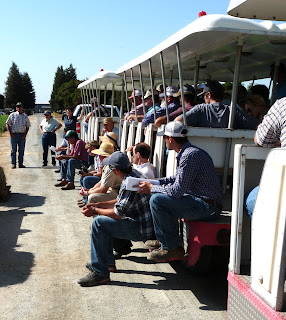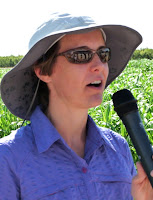
 |
| Attendees on the Kearney Trams during a Field Tour. |
A California Ag TODAY Exclusive
UC Researchers Fill the Gaps on Many Questions
By Patrick Cavanaugh, Editor
Nearly 100 alfalfa and other forage growers and pest control advisors gathered TODAY at the Kearney Research and Extension Center in Parlier, Calif.
Shannon Mueller, UC Cooperative Extension Agronomy Farm Advisor, Fresno County, spoke about the importance of alfalfa variety selection as a tool for managing pests and disease.
 |
| Shannon Mueller, Ph.D. |
The different regions where alfalfa is produced determine which pests are most important for resistance varieties. “Alfalfa varieties consist of a population of plants which have varying degrees of resistance to an insect or disease. Since alfalfa fields can sustain considerable loss of individual plants without reducing productivity, alfalfa varieties with 51 percent or more plant resistance in the field are considered to be highly resistant (HR), as resistant plants will make up for losses from other plants.
Alfalfa is heterozygous and no plant population would have the same resistance strength.
She noted that growers should know the pest and disease pressure in their areas and buy seed that has the resistance quality needed.
 |
| Dan Putnam, Ph.D. |
And since alfalfa is a nitrogen-fixating crop producing between 250 and nearly 1000 pounds of N per acre, it could serve as a rotation crop, with wheat for example. “The actual amount depends upon yield and protein concentration. Although most of this N is removed in the crop, some portion remains to benefit the succeeding crop,” said Dan Putnam, UC Davis Agronomy Extension Specialist.
“We want to determine the impacts of rotation with alfalfa on the N fertilization needs of a following crop, such as wheat. We would like to develop an N credit recommendation for management of N fertilizers in non-legumes, rotated with alfalfa. He will have data from his experiment in 2014.
Putnam also discussed UC sorghum nitrogen and variety studies. “Sorghum has been proposed as an alternative forage, primarily as a summer annual silage crop for dairy or other livestock production,” Putnam said. “The primary value of sorghum in the Central San Joaquin Valley, under irrigation, is that it is likely to use less moisture and N than corn, which is currently a major forage crop in California.”
He reported on N-sorghum trials from 2011 and 2012, conducted in three locations. The trials are being repeated this year.
He noted the major advantages of sorghum include:
· Less expensive to establish
· Lower N requirement/lower inputs
· Lower water requirement/ drought resistance
· Heat Tolerant
Major Limitations:
· Lodging issues in some varieties
· Forage Quality (seed percentage/variety specific)
· Yield (variety dependent/ compared with seed costs)
Following Putnam was a discussion on how to detect if Roundup Ready (RR) alfalfa is present in a sample. “There are concerns among growers, marketers, and the general public about the co-existence of RR and conventional alfalfa,” said Michelle Leinfelder-Miles, UC Farm Advisor, San Joaquin County. “Key among the concerns is the possibility for the RR trait to transfer by pollen to conventional alfalfa.”
Gene flow has been measured between alfalfa fields grown for seed production; however, gene flow between fields grown for hay is largely prevented by management barriers. The primary barrier is that hay is generally cut before 10 percent flowering so seed is rarely allowed to form, let alone mature.
However, it is courteous and wise to employ practices that allow the co-existence of RR and convention alfalfa. Several important considerations include:
· Growing certified seed.
· Understanding the potential for gene flow. Cross-pollination is required in seed production but not in forage production.
· Preventing the mixing of hay lots or carry-over bales between fields
· Being aware of neighboring non-genetically engineered (GE) hay.
“Testing for GE Traits is a good way to insure that they do or do notexist when a customer is sensitive to GE crops,” Leinfelder-Miles said. Specific test strips are available to easily and quickly determine if an alfalfa sample is RR. Contact Leinfelder-Miles for more information on testing supplies.
 |
| Jeff Dahlberg, Ph.D. |
There was also a discussion on Sorghum Variety Trials, presented byJeff Dahlberg, Director, Kearney Agricultural Research and Extension Center. Sorghum, both grain and forage, is a an important feedstuff for livestock, as well as a fuel stock.
Dahlberg is working on a major trial with many different sorghum varieties. He is measuring how all of them stack up regarding fall dormancy, winter survival, all major pests and diseases, salt tolerance and continuous grazing tolerances. He mentioned many very good varieties for California Production.
Nearly all forage sorghum growers are interested in trying to grow crops with less water, and Bob Hutmacher, UC Davis, Department of Plant Sciences, Shafter Research and Extension Center, presented research that shows respectable yields with three to four fewer inches of water.
 |
| Bob Hutmacher, Ph.D. |
He stated that he and colleagues are working on different irrigation timings as well as different amounts of water on distinct forage and grain sorghum varieties in several locations. “We are testing forage types and grain types, but all were cut for silage in the trials,” Hutmacher said. “We are seeing some results that even with lower yields due to decreased water, there still can be a profitable yield.” He noted that the yield differences were less on the grain sorghum than on the forage sorghum.
 |
| Steve Wright |
Steve Wright, UC Cooperative Extension Agronomy Farm Advisor, Tulare County spoke about the N needs of wheat.
“You need to fertilize according to yield potential,” Wright said. “Some varieties will yield five tons per acre, and they will require about 300 pounds on N per acre.
“Growers need to develop variety/nitrogen management strategy what would assure maximum yield and acceptable protein for all growing areas,” Wright said. “Recent research indicates that applying N at plating, tillering, boot, and flowering on newer varieties may increase yield and protein, however more research is needed,” he noted.
 |
| Larry Godfrey, Ph.D |
Wright noted that a good rule of thumb is three to five pounds N per 100 pounds yield. “However ground water contamination is an important consideration regarding N-use. But I think growers can manage their N so that it will not cause any further problems,” Wright said.
Following Wright was a discussion on the Blue Alfalfa Aphid that caused enormous problems for growers throughout the state this year. The pest populations were very high, the usual materials were not working, and so there were yield reductions. Heading up the discussion was Larry Godfrey, a UC Davis Extension Entomologist.
Godfrey described the biology of the Blue Alfalfa Aphid and said there are several generations per year. He said the pest injects a toxin into the plant while feeding, which causes much more damage than the Pea Aphid.
 |
| Tim Hayes |
Tim Hays, a PCA with Wilbur-Ellis, Shafter Branch, reported the Blue Alfalfa Aphid was a big problem in the 1970s, and it has always been at least a minor problem each year. “This year we had very high aphid numbers; we sprayed but did not get control. We had good materials that worked well on the aphid until this season. Clearly this is a resistance issue and the answer we need is new materials,” Hays said.
Godfrey noted that there is no apparent evidence that the failure this year was caused by insecticide resistance, and this did not appear to be a failure of the alfalfa’s resistance.
A Section 18 was filed for the use of another effective material for the 2014 season. Godfrey noted that the Section 18 might be canceled soon because a particular registrant has a new product and the company anticipates it will be registered in 2014 for use in the alfalfa industry.
And finally, Kurt Hembree UC Cooperative Extension Weed Management Farm Advisor, Fresno County, spoke about weed management in alfalfa with and without Roundup, on Roundup Ready stands.
He noted that growers need to plan their program strategy around the weeds that they have or expect, and dedicate extra efforts to control as many weeds as possible during early stand development.
“When using glyphosate in seedling fields, treat the first time at the third trifoliate leaf stage,” Hembree explained. “Earlier or later timings can result in more weeds escaping control. And growers must expect some crop injury if tank-mixing with other herbicide materials.”
Hembree noted that it’s important to preserve the effectiveness of glyphosate. “Growers need to control escapes and rotate and/or tank-mix other materials as often as necessary,” he said.
He noted that a survey indicates that a large majority of growers are pleased with the Roundup Ready technology in alfalfa because it provides better weed control with simplicity. “However, more than half the growers surveyed are not concerned with glyphosate-tolerant or glyphosate-resistant weeds in alfalfa. The growers who think this way are in trouble,” said Hembree. He stressed: “If you want these products to be around, then you must make smart decisions.”










